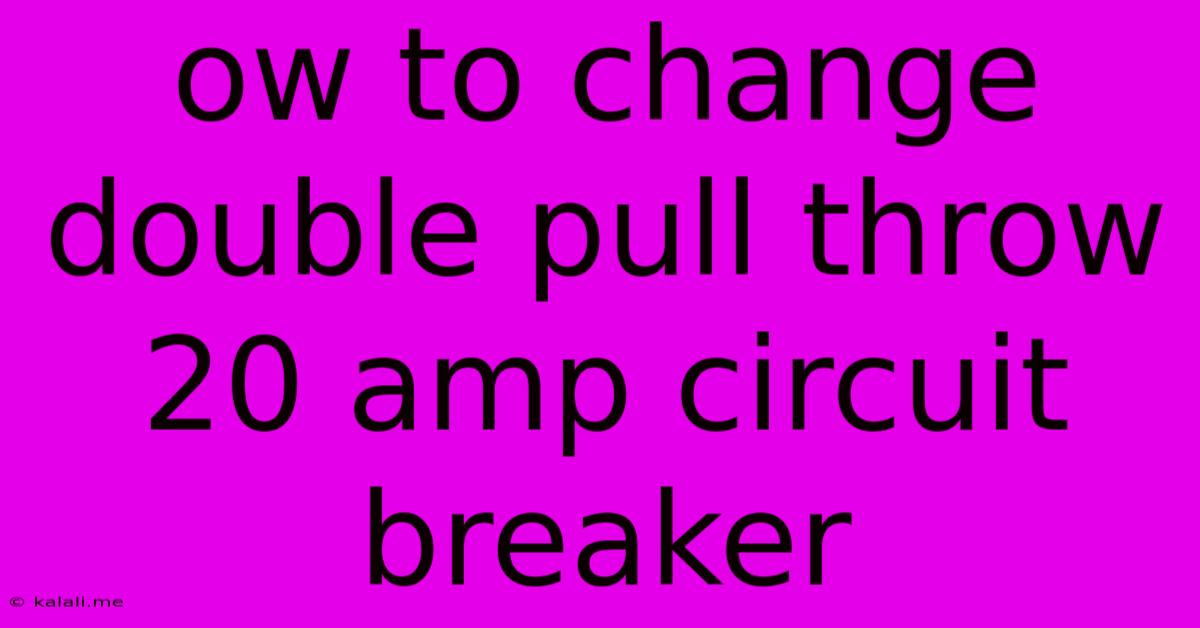Ow To Change Double Pull Throw 20 Amp Circuit Breaker
Kalali
May 26, 2025 · 3 min read

Table of Contents
How to Change a Double-Pole 20 Amp Circuit Breaker
Replacing a double-pole 20-amp circuit breaker might seem daunting, but with the right steps and precautions, it's a manageable DIY project. This guide provides a clear, step-by-step process, emphasizing safety to help you confidently tackle this electrical task. This article is for informational purposes only. If you are uncomfortable working with electricity, consult a qualified electrician.
Before you begin: Always turn off the power to the breaker panel. Double-check that the power is off using a non-contact voltage tester. This is crucial for your safety and prevents electrical shock. Improper handling can lead to serious injury or even death. This process involves working with potentially lethal voltages.
1. Gather Your Tools and Materials
Before starting, gather the necessary tools:
- New 20-amp double-pole circuit breaker: Ensure the replacement breaker is the correct amperage and type. Match the existing breaker's specifications precisely.
- Voltage tester: A non-contact voltage tester is essential to verify the power is off.
- Screwdriver: A flathead screwdriver is typically needed to release the breaker. Phillips head might also be required depending on the breaker panel.
- Pliers (optional): May be helpful for removing stubborn wires.
2. Turning Off the Main Power
While you'll be working on a specific circuit, it's best practice to switch off the main power to the entire electrical panel as an extra precaution. This ensures complete safety while you work.
3. Locating the Faulty Breaker
Identify the double-pole 20-amp breaker you need to replace. Double-pole breakers usually occupy two adjacent spaces in the breaker panel. They often control larger appliances like electric ranges or ovens.
4. Releasing the Breaker
Most breaker panels have a simple mechanism for releasing the circuit breaker. Carefully push the breaker toward the panel slightly, and then pull it straight out. It might require a little pressure, but avoid excessive force to prevent damage.
5. Removing the Wires
Once the breaker is out, you'll need to disconnect the wires. These are usually connected to the breaker using screws. Carefully loosen these screws and remove the wires. Take note of their placement—a photo can help, especially with multiple wires.
6. Installing the New Breaker
Carefully insert the new 20-amp double-pole circuit breaker into the empty space in the panel. Ensure it sits firmly and clicks into place.
7. Reconnecting the Wires
Reconnect the wires to the new breaker, matching their positions to how they were connected to the old breaker. Tighten the screws securely to ensure a good connection.
8. Turning the Power Back On
After securely connecting the wires, carefully switch the main power back on.
9. Testing the Circuit
Finally, test the circuit to ensure everything is working correctly. Turn on the appliance controlled by this breaker. If it functions properly, the replacement was successful. If not, double-check your connections. If the problem persists, contact a qualified electrician.
Safety Precautions: A Final Reminder
Working with electricity can be dangerous. Always prioritize safety. If you're uncomfortable performing these steps, contacting a qualified electrician is the safest option. Never rush the process. Take your time and double-check everything before turning the power back on. Misconnections can lead to electrical fires and other hazards.
Latest Posts
Latest Posts
-
Mcgonnagall Asking About Leaving Harry With Muggles
May 27, 2025
-
How Long Can You Keep A Fresh Turkey In Refrigerator
May 27, 2025
-
Can I See A Doctor Without Photo Id
May 27, 2025
-
How To Clean Up Battery Acid
May 27, 2025
-
How To Remove Screw With Stripped Head
May 27, 2025
Related Post
Thank you for visiting our website which covers about Ow To Change Double Pull Throw 20 Amp Circuit Breaker . We hope the information provided has been useful to you. Feel free to contact us if you have any questions or need further assistance. See you next time and don't miss to bookmark.